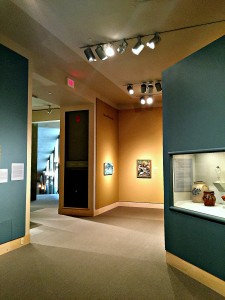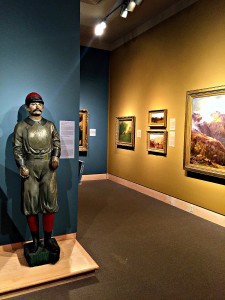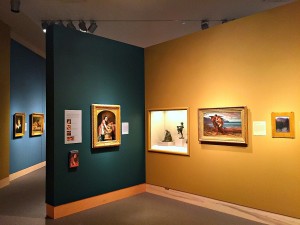Gallery Layout and Atmosphere Help Shape the Exhibition Experience

While visual techniques do play an important role in shaping the viewer experience, non-visual cues also contribute irreplaceably to the interaction between the viewer and the gallery. The placement of the structure in the center of the gallery serves dual purposes, as a way to direct viewers down a path and as a space for extra displays. After entering the gallery, viewers are forced to choose between turning left or right and following a relatively narrow path around the room. This allows for visual aspects of the gallery to work as intended, shaping how the viewer follows the carefully-designed patterns and influencing the kind of experience a viewer will get from walking through it.

The second function that the central structure serves is as a space for more art to be displayed. While this seems like an unimportant design feature, it still directs the viewing experience by encouraging visitors to walk around the gallery twice, once to observe the paintings on the outside walls and once to observe the artwork on the central structure. Taking two laps around the gallery also encourages viewers to slow down, knowing that a quick and easy look around the gallery is not possible. As techniques for affecting the interaction between viewers and the gallery, the main purpose of this structural feature is to set up the visual techniques as a sort of auxiliary form of experience-shaping.

In addition to these more obvious non-visual features of the gallery, there are also minor features that contribute to a viewer’s overall experience of the space. The room, due to its high ceilings and sharp corners, transmits echoes very well throughout the space. Whispers can be heard across the gallery, causing visitors to feel self-conscious when speaking too loudly. This creates a quiet, contemplative atmosphere in the room, which can lead to viewers spending more time looking closely at the art.

The size of the space also affects how viewers interact with the art. The room is relatively small and the center structure is very large, creating walkways that are relatively crowded (in contrast to large public museums that are very open and airy). This forces visitors to be closer to the paintings and artifacts, encouraging more intensive observation and interaction with the art, especially in corners where visual contrast is most prominently used to shape the viewing experience. Despite these being minor design choices (or consequences), together they have a very large influence on how a viewer perceives the gallery independent of the collection displayed in it.